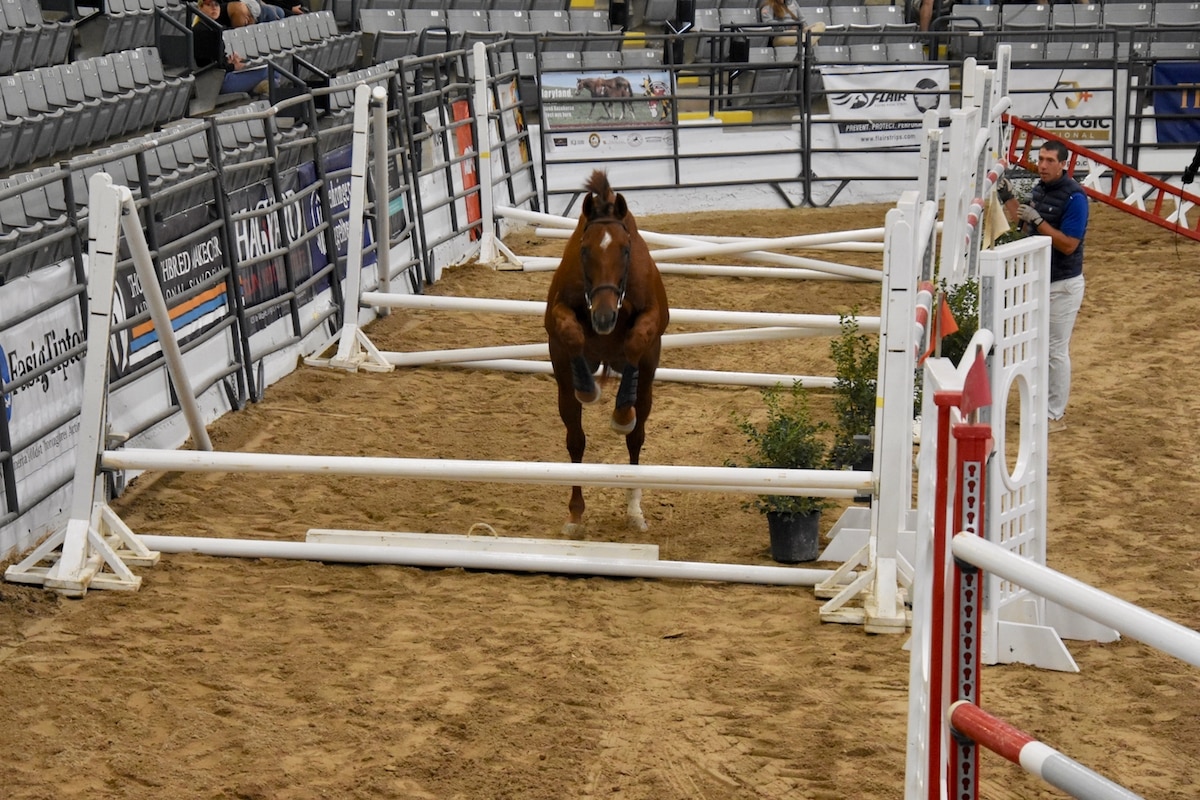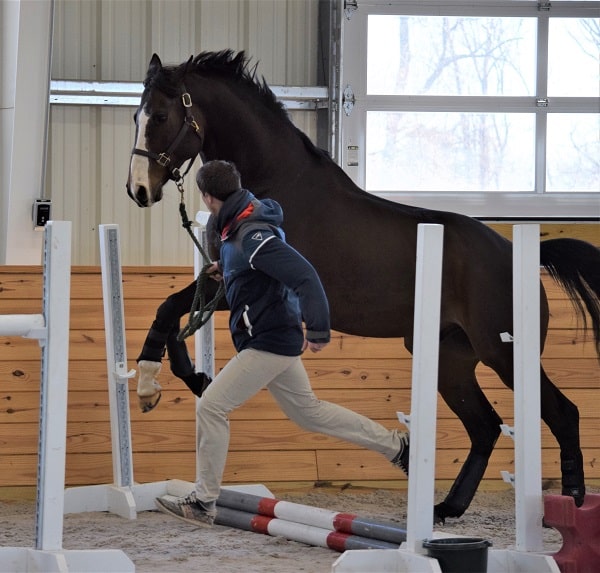How trainers can use a jump chute to give OTTBs a positive introduction to jumping

Free jumping provides a safe and positive introduction to jumping for a horse that has not previously been trained for it. Courtesy Giulia Garcia
Growing up in Vaucluse, France, Martin Douzant was surrounded by a booming breeding industry — not of Thoroughbred racehorses, but of sport horses.
An avid rider from the time he was 4, Douzant immersed himself in the industry as a young eventer and found his niche in young horse development, which led to him founding The Frame Sport Horses in 2009. Six years later, Douzant made the move stateside, putting down roots in The Plains, Virginia, to open a U.S. division of his business. But when he arrived, he found an industry with a very different look.
“In our breeding program, horses free jump in all breeding classes,” he says. “It’s mandatory for the stallion auctions. When I moved to the U.S., I was involved in breeding classes, but I didn’t realize that the horses didn’t free jump until I went to the FEH (Future Event Horse) Championships, where there is a championship specifically in that category. The class did not go well.”
Douzant suddenly found himself with a new specialty within his business. He now offers training, clinics and courses specifically for free jumping, educating horses and horsemen alike. As Douzant has navigated the role, he’s worked frequently with horses transitioning to sport careers from the racetrack, and he’s led several demos for the Retired Racehorse Project.
“We have quite a few Thoroughbreds to retrain in our program,” Douzant says. “Free jumping can be useful for all young horses in general.”
Free jumping, he says, presents myriad benefits for OTTBs. It provides a safe and positive introduction to jumping for a horse that has not previously been trained for it and, for horses that have already started over fences, trainers can use free jumping to correct technique through gymnastics and grid work. Most importantly, it can be a helpful assessment tool when deciding on a career for a horse in transition.
“Most of the time Thoroughbreds get picked (for sport) off of the racetrack,” Douzant says. “They’re trained to race, and usually they are bought for new careers off of a video of a trot back and forth. The main thing (free jumping can help with) at first is to assess a horse’s potential and to see them move. You can also see a little bit of their temperament — whether they are calm, nervous or excited” in the environment.
Specifics on Setup
When Douzant sets up a jump chute, he places the most emphasis on establishing a controlled environment. Trainers should conduct free jumping in either an indoor or outdoor 36-by-18-meter oval pen with high walls (equivalent to about a 120-by-60-foot arena or pen).
“You want it a little (narrower) than a dressage arena so that the turn can slow the horse down instead of having them picking up speed,” Douzant says, “and long enough to have three jumps on the long side — with one stride in between two introductory verticals and one stride before a final oxer.”
There are two ways to conduct a free jumping session: completely loose or with a catch-and-release setup. When a horse free jumps loosely, a handler “pushes” the horse around using a whip or body motion for guidance. This method allows you to assess a horse’s jump as well as his movement as he loosely trots or canters around the opposing long side of the chute. With catch-and-release, a handler catches the horse after he completes the grid and walks him back to the top of the chute. Regardless of the method, Douzant recommends introducing the horse to the environment in stages — first without jumps, then with poles on the ground, then adding one jump at a time. After you have introduced all three jumps, you can raise them gradually and progressively, depending on how the horse responds.
“We will raise or lower jumps, depending on what the horse needs,” Douzant says. “One session is about 20 minutes. The horses get very tired. They’ll go through the chute probably about 10 to 12 times during a training session.”
The element of control relates to speed, especially when working with horses that have previously been trained to run at high speeds around an oval-shaped track. Emphasizing calmness and slowness in the jump chute is a key focus (see sidebar), and Douzant works primarily using catch-and-release free jumping methods with Thoroughbreds to ensure greater control.
“You want to control the horse’s stride and their straightness — the same as when you’re riding,” he says.
Sighting in on Success

Introduce the horse to the chute in stages — first without jumps, then with poles on the ground as Martin Douzant demonstrates here, then adding one jump at a time. Courtesy Martin Douzant
Again, free jumping is not just a training tool; it’s also a way to gather information.
“Usually, our people like to make videos for sale purposes or to analyze afterward,” says Douzant. “It allows us to watch how the horses want to jump naturally.”
He says he often identifies strengths and weaknesses in a horse’s jumping technique based on the animal’s head carriage, shoulder usage and stride control. While a superior jumper checks every box — possesses a good bascule, uses his back, lengthens and shortens his stride naturally between the fences and has tidy knees — Douzant looks for intelligence and a quick front end when identifying talented OTTBs.
“A lot of racehorses go into the eventing world, and you need a smart, fast-thinking horse,” he says. “You want a horse that’s going to help the rider if a mistake is made.”
Douzant advises against using a horse’s first attempt at free jumping to determine his jumping proficiency; it is a process that takes practice. When observing a horse free jump, it’s important to take notes on how you can use this method to improve or correct.
“We will find out that some horses like to lower their head in order to raise their withers to jump well,” he says. “Others jump with their head high, some have trouble adjusting or compacting their stride in between the jumps, and some don’t use their topline enough. We can try to improve that.
“It’s interesting to watch the horses by themselves,” he adds. “You need to understand what the horse needs and how he’s comfortable. You can get more information from free jumping than anywhere else.”
Do’s and Don’ts
When pursuing free jump training for a horse, Martin Douzant recommends the rider seek training in the area as well, and he offers clinics that focus on teaching individuals how to navigate the process themselves.
He offers readers some helpful tips to use as they learn the art of navigating the jump chute:
Do: Keep the whip down“A horse needs to be used to being pushed where to go by using the whip,” Douzant says, “but Thoroughbreds, by nature, are sensitive and usually very reactive to the whip. When working with a lazy horse, you can keep the whip up, but for a Thoroughbred that already has a lot of stamina and wants to go fast, I keep the whip down and use my body posture to make them move where I want them to go.”
Do: Read your horse “Always try to read your horse as you work with them. You don’t want to go too high (with the jump) too fast,” he says. “The horse needs to be comfortable, and you can’t be too greedy in terms of height. Be progressive with the process.”
Don’t: Use the jump chute alone “You can’t do it by yourself,” he says. “You need to do it with someone that also knows what they’re doing.”
Don’t: Go straight to the jump chute “You can’t take a horse from the racetrack that is race fit and all ready to go racing and expect them to jump well in the jump chute. It doesn’t work,” Douzant says. “Make sure the horse has had a bit of letdown time — just that he had time to calm his brain and take a little bit of rest. It’s part of the restarting process.”
Do: Use your voice “It’s very important to talk to your horse,” he says. “When it comes to nervous racehorses, you need to ‘whoa’ them quite a bit and talk to them. The horse needs to understand to (navigate the jump chute) slowly, not fast.”

